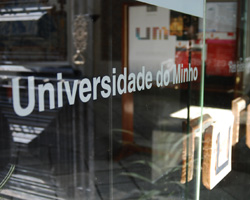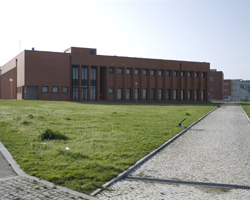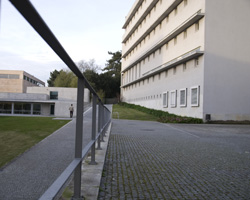Curricular Unit
Advanced Physics Topics 1
Module
Materials Growth Techniques and Electronic Microscopy
Type
Lecture course
Contact hours
18
Professor/Researcher in charge
Florinda Costa/Augusto Barros Lopes U. Aveiro
Summary of Contents
This module is designed to provide a broad view of the principles and fundamentals of different materials growth techniques namely the chemical and physical deposition methods, the single crystals growth methods as well as basic materials characterization techniques such as those based on electron microscopy.
Contents Programme
1. Electronic microscopy
1.1. The electron microscopy as a materials characterization technique
1.2. The depth of field and the resolution limit of the optical microscope
1.3. Advantages of using electrons
1.4. The basic constitution and working principles of the scanning electron microscope (SEM), the transmission electron microscope (TEM) and the scanning transmission electron microscope (STEM).
1.5. Sample preparation for SEM and TEM
1.6. The Energy Dispersive Spectroscopy (EDS).
1.7. SEM and EDS practical demonstration
1.8. The interaction volume. Influence of the atomic number, thickness, electron beam energy and sample tilting.
1.9. SEM observation modes. Secondary and backscattered electron image modes.
1.10. TEM Image and diffraction modes
1.11. TEM Contrast. Mass-Thickness contrast, diffraction contrast (bright and dark field image modes) and phase contrast
1.12. TEM practical demonstration
2. Materials Growth techniques
1. Thin Films: PVD process
1.1 Thin film materials
1.2 Thin film devices
2. Thin film processes
2.1 Thin film growth process
2.2 Thin film deposition process
2.2.1 Classification of deposition processes: PVD and CVD processes
2.2.2 Deposition conditions
2.3 Characterization
3. Sputtering phenomena
3.1 Sputter yield
3.2 Sputtered atoms
3.3 Mechanisms of sputtering
4. Sputtering systems
4.1 Discharge in a gas
4.2 Sputtering systems
4.2.1 Dc diode sputtering
4.2.2 RF diode sputtering
4.2.3 Magnetron sputtering
4.2.4 Ion beam sputtering
4.2.5 ECR plasma
4.2.6 Medium-frequency sputtering
4.3 Practical aspects of sputtering systems
4.3.1 Targets for sputtering
4.3.1.1 Compound targets
4.3.1.2 Powder targets
4.3.1.3 Auxiliary cathode
4.3.2 Sputtering gas
4.3.3 Thickness distribution
4.3.4 Substrate temperature
4.3.5 Off-axis sputtering; facing-target sputtering
4.3.6 Monitoring
4.3.6.1 Gas composition
4.3.6.2 Sputtering discharge
4.3.6.3 Plasma parameters
4.3.6.4 Substrate temperature monitoring
4.3.6.5 Thickness monitoring
4.3.6.6 Film structure
5. Deposition of compound thin films
5.1 Oxides
5.1.1 ZnO thin films
5.1.1.1 Deposition of ZnO
5.1.1.2 Electrical properties and applications
6 Practical work in the laboratory
6.1 Deposition of a semiconductor film by Rf magnetron sputtering and some basic characterization.
2. Chemical vapour deposition (CVD) method
2. 1 Introduction to the CVD process
2. 2 CVD reactors and growth parameters
2. 3 CVD carbon structures
2.3.1 Nucleation and growth mechanisms
2.3.2 Structure and properties of carbon nanostructures
2.3.3 Applications of carbon nanostructures
Practical work in the laboratory
3. Crystals Growth Methods
3.1. Introduction to the solidification process
3.1.1 Solute transport and distribution coefficient
3.1.2 Constitutional supercooling
3.1.3 Solidification interface
3.2. Czochralski method
3.2.1 Growth conditions
3.2.2 Single crystalline silicon
3.3. Laser Floating zone (LFZ)
3.3.1 Directional solidification and zone melting
3.3.2 Fibre single crystal and fibre textured polycrystals
3.3.3 Effect of an electrical current application during the LFZ process
3.3.4 LFZ equipment and growth parameters
3.3.5 Application of LFZ technique to different materials
Practical work in the laboratory
References
Thin film materials technology : sputtering of compound materials / by Kiyotaka
Wasa, Makoto Kitabatake, Hideaki Adachi, 2003.
Handbook of deposition technologies for films and coatings, Second Edition: edited by Rointan F. Bunshah, 1994.
Properties, growth and applications of diamond”, ed. M.H. Nazaré and A.J. Neves, INSPEC, The Institution of Electrical Engineers, London, United Kingdom (2001)
Zone Melting, William G. Pfann, John Wiley & Sons, Inc.
D.B. Williams e C.B. Carter, Transmission electron microscopy - textbook for materials science, 3ª edição, Springer, 2009.
J.I. Goldstein, D.E. Newbury, P. Echlin, D.C. Joy, C.E. Lyman, E. Lifshin, L. Sawyer, and J.R. Michael, Scanning Electron Microscopy and X-Ray Microanalysis, Kluwer Academic/Plenum Publishers, New York, 2003.






